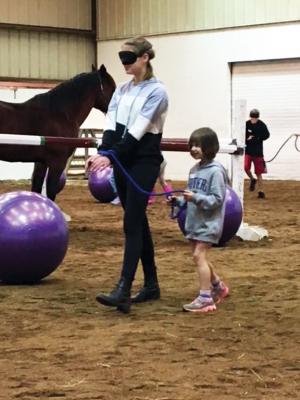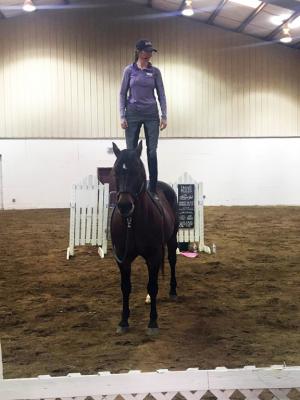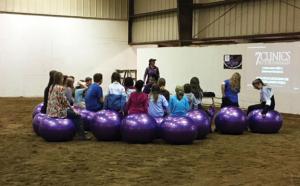By Nancy Brannon
Dee Pellegrini, at Aintree Stables in Germantown, Tenn., took advantage of the Presidents’ Day Holiday, February 19, 2018, to host a Natural Horsemanship clinic with Robyn Miller of Mt. Pleasant, Mississippi. The focus of the clinic was groundwork: teaching young riders about human-horse communication with body language. There were 17 participants in the non-mounted, afternoon clinic.
Groundwork is the essential first step in horse training and human-horse communication. What is groundwork? “Everything you do with your own two feet on the ground,” Robyn explained. The goal is to have the horse respond in a positive, non-resistant way to human cues/requests. To do so, the horse must understand what the human wants and the human must be able to clearly communicate those desires to the horse. It is an essential element taught by all “natural” horsemen, beginning with the masters Ray Hunt and Buck Brannaman. Yet, many young riders miss this important step that must be mastered, and which results in better ridden work. Robyn attended three clinics with Buck Brannaman last year, and he is a great influence on how she trains horses.
Robyn’s goals were to help the students understand the body language of the horse, including warning signs from the horse of possible dangerous moves toward humans. The clinic was geared toward understanding the importance of groundwork with the horse and communication with the horse. “There were lots of good questions,” Robyn said, “and the kids had lots of fun. They were excited and got really involved with the exercises.”
She began instruction with excerpts from two Buck Brannaman videos, demonstrating the importance of pressure-release and how groundwork can improve mounted work. During the lecture portion, Robyn had the students “ride” on giant yoga balls, which are a great tool to help the students with balance.
Then Robyn used her own horse, a 17-year-old Quarter Horse stallion, Rebel, to demonstrate what good communication looks like. She taught the students how to use body language to control the horse and to understand the horse’s own body language in response. For example, she taught the participants how to move the horse’s hindquarters over and get favorable results. The students got to experience the correct way to do the maneuvers with the experienced horse, Rebel.
Then she worked with a horse at Aintree who had not had the extensive groundwork that her own horse had. The students got to see an example of “not so good” communication, and the horse had some issues that had to be dealt with. Robyn demonstrated some desensitizing techniques to calm and quiet a reactive horse.
In another exercise, she paired members of the group into partners, connected by lead ropes, and blindfolded one to demonstrate how the horse might interpret our cues and understand, or misunderstand, what to do. She used this opportunity to explain how the horse sees and thinks.
Overall, Dee said, “It was a great day, and everyone had a fun time.” There were refreshments afterward, and the weather was a warm (70s) spring-like day with some welcome sunshine. Dee said that she plans to make this a yearly event at Aintree.
Dee Pellegrini, at Aintree Stables in Germantown, Tenn., took advantage of the Presidents’ Day Holiday, February 19, 2018, to host a Natural Horsemanship clinic with Robyn Miller of Mt. Pleasant, Mississippi. The focus of the clinic was groundwork: teaching young riders about human-horse communication with body language. There were 17 participants in the non-mounted, afternoon clinic.
Groundwork is the essential first step in horse training and human-horse communication. What is groundwork? “Everything you do with your own two feet on the ground,” Robyn explained. The goal is to have the horse respond in a positive, non-resistant way to human cues/requests. To do so, the horse must understand what the human wants and the human must be able to clearly communicate those desires to the horse. It is an essential element taught by all “natural” horsemen, beginning with the masters Ray Hunt and Buck Brannaman. Yet, many young riders miss this important step that must be mastered, and which results in better ridden work. Robyn attended three clinics with Buck Brannaman last year, and he is a great influence on how she trains horses.
Robyn’s goals were to help the students understand the body language of the horse, including warning signs from the horse of possible dangerous moves toward humans. The clinic was geared toward understanding the importance of groundwork with the horse and communication with the horse. “There were lots of good questions,” Robyn said, “and the kids had lots of fun. They were excited and got really involved with the exercises.”
She began instruction with excerpts from two Buck Brannaman videos, demonstrating the importance of pressure-release and how groundwork can improve mounted work. During the lecture portion, Robyn had the students “ride” on giant yoga balls, which are a great tool to help the students with balance.
Then Robyn used her own horse, a 17-year-old Quarter Horse stallion, Rebel, to demonstrate what good communication looks like. She taught the students how to use body language to control the horse and to understand the horse’s own body language in response. For example, she taught the participants how to move the horse’s hindquarters over and get favorable results. The students got to experience the correct way to do the maneuvers with the experienced horse, Rebel.
Then she worked with a horse at Aintree who had not had the extensive groundwork that her own horse had. The students got to see an example of “not so good” communication, and the horse had some issues that had to be dealt with. Robyn demonstrated some desensitizing techniques to calm and quiet a reactive horse.
In another exercise, she paired members of the group into partners, connected by lead ropes, and blindfolded one to demonstrate how the horse might interpret our cues and understand, or misunderstand, what to do. She used this opportunity to explain how the horse sees and thinks.
Overall, Dee said, “It was a great day, and everyone had a fun time.” There were refreshments afterward, and the weather was a warm (70s) spring-like day with some welcome sunshine. Dee said that she plans to make this a yearly event at Aintree.











